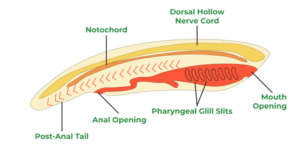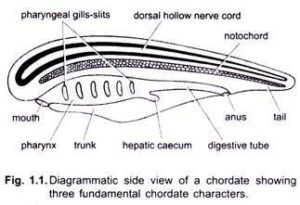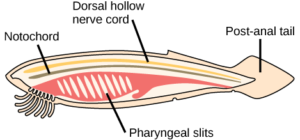Back to: ZOOLOGY 300 Level
WELCOME TO CLASS! Today’s topic is really interesting and central to your journey in Zoology—it’s one of those foundational lessons that make everything else clearer. So, let’s get right into it like good friends catching up on something fascinating!
Fundamental Chordate Characteristics (Notochord, Dorsal Nerve Cord, Etc.)
You know how every building stands on a solid foundation? In the same way, all vertebrate animals—like fish, birds, reptiles, amphibians, and mammals (including you and me)—have certain basic features that group them together. These features are called fundamental chordate characteristics. The term “Chordata” refers to a major group in the animal kingdom that shares these unique traits, especially during early development. Even the simplest member of this group, like a tiny marine animal called Amphioxus, still carries the same basic identity.

Notochord
One of the most important features is the notochord. This is like a flexible rod that runs along the back of the animal. You can think of it like the wooden frame inside a traditional African drum—it gives shape and support. In most animals, this notochord later develops into the spinal column. But in some, like Amphioxus, it stays as it is throughout life.
Dorsal Nerve Cord
Next is the dorsal nerve cord. Unlike other animals that have their nerve cords on the belly side (ventral), chordates have theirs on the back (dorsal) side. And guess what? This cord later becomes the spinal cord and brain in vertebrates. Imagine it as a long cable that sends messages all over your body, helping you feel, move, and think!
Pharyngeal Slits
Chordates also have pharyngeal slits at some point in their life. These are openings in the throat area, which in fishes become gills. In humans, they don’t form gills, but they do help in the development of parts of the ear and throat.

Post-Anal Tail
Another key trait is the post-anal tail. This is a tail that stretches beyond the anus. Think of how a lizard’s tail continues after its backside—yes, that’s the idea. In humans, this tail is present during early development and becomes the tiny bone we call the coccyx.
Ventral Heart
Finally, all chordates have a ventral heart, which means the heart is located towards the lower side of the body and helps pump blood effectively throughout the organism.
Let’s tie this to real life. Think about a cat chasing a rat, or a fish swimming upstream, or even you playing football. All these actions rely on a strong backbone, a well-connected nervous system, and smooth movement—thanks to these chordate features. Whether you’re looking at a bird flying across the sky or a goat grazing in your compound, you’re seeing chordate characteristics in action.

Summary
- Chordates are animals with a notochord at some point in life.
- They have a dorsal nerve cord, not a ventral one.
- Pharyngeal slits are present in early development.
- They have a post-anal tail.
- A ventral heart is common to all chordates.
Evaluation
- Mention three fundamental characteristics of chordates.
- Explain the difference between a dorsal and ventral nerve cord.
- What happens to the notochord in vertebrates?
- Name one example of an animal that keeps its notochord for life.
You are doing so well! Keep your curiosity alive and know that with Afrilearn, you’re building a solid foundation for greatness. Let’s keep learning, growing, and becoming the best versions of ourselves. See you in the next lesson, superstar!
